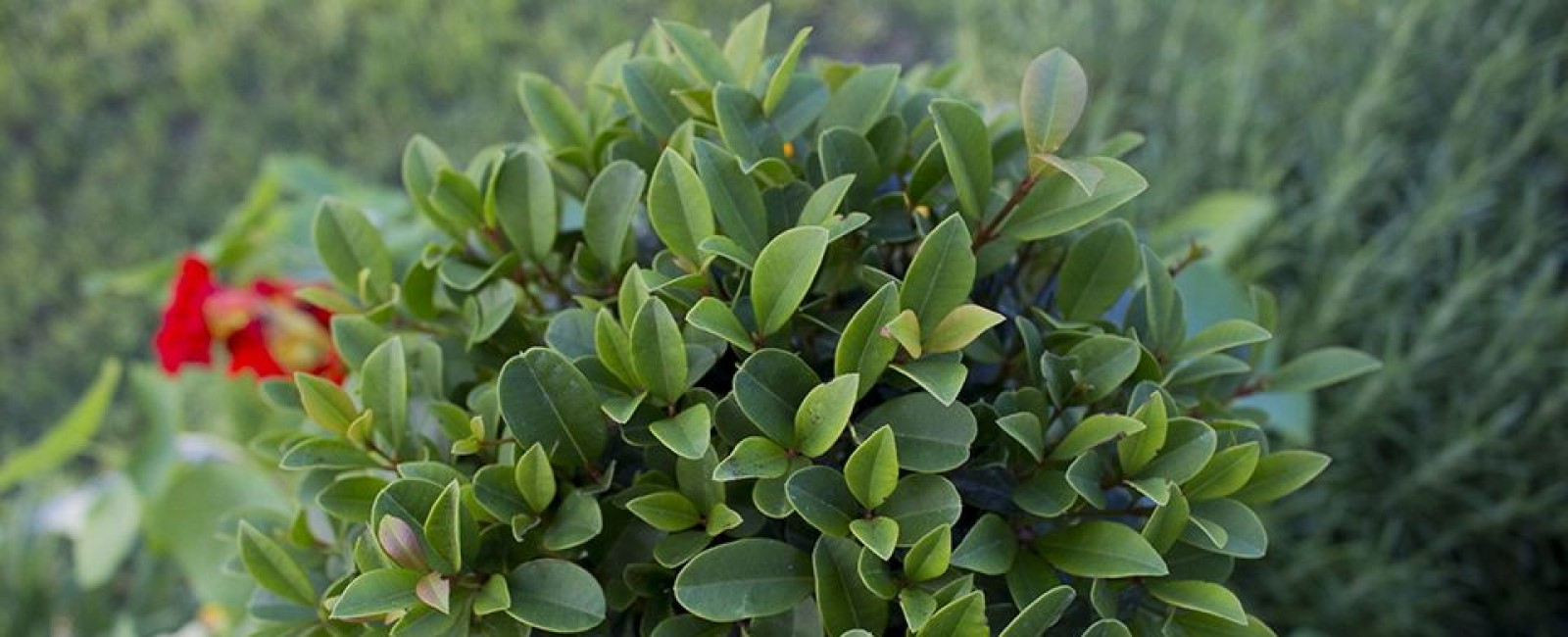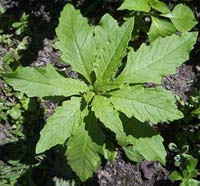Herb of the Month
Tender, semiwoody perennial Craft, Culinary, Medicinal 5 ft. high, 2 ft. wide Full sun to partial shade Light, well-drained soil |
Epazote, (Chenopodium amborsiodes)
Family: Chenopodiaceae |
|
Epazote is an annual herb that grows to about 1 ft. in height. It has multi-branched, reddish stems covered with small, sharply toothed leaves. Epazote bears numerous small yellow flowers in clusters along its stems. Following the flowers, it produces thousands of tiny black seeds in small fruit clusters. It is easily spread and re-grown from the numerous seeds it produces which is why some consider it an invasive weed. The whole plant gives off a strong and distinctive odor. Epazote is native to Mexico and the tropical regions of Central and South America where it is commonly used as a culinary herb as well as a medicinal plant. It has been widely naturalized throughout the world and can be found growing in parts of the southern United States. In Brazil the plant’s name is erva-de-santa-maria or mastruço; in Peru its called paico. It is known throughout Mexico and Latin America as epazote. The Siona name of this plant means worm remedy and here in America it is referred to as wormseed – both referring to it long history of use against intestinal worms. TRIBAL AND HERBAL MEDICINE USESIn the Yucatan, indigenous Indian groups have long used epazote for intestinal parasites, asthma, excessive mucus, chorea (a type of rheumatic fever that affects the brain) and other nervous afflictions. The Tikuna Indians in the Amazon use it to expel intestinal worms and as a mild laxative. The Siona-Secoya and Kofán Indian tribes in South America also use epazote for intestinal worms (usually by taking one cup of a leaf decoction each morning before eating for three consecutive days). The Kofán Indians also use the plant as a perfume-tying it to their arm for an ‘aromatic’ bracelet. (However, most Americans consider the smell of the plant quite strong and objectionable – calling it skunk-weed!) Creoles use it as a worm remedy for children and a cold medicine for adults while the Wayãpi use the plant decoction for stomach upsets and internal hemorrhages caused by falls. In Piura a leaf decoction is used to expel intestinal gas, as a mild laxative, as an insecticide, and as a natural remedy for cramps, gout, hemorrhoids, intestinal worms and parasites and nervous disorders. Some indigenous tribes bathe in a decoction of epazote to reduce fever and will also throw a couple of freshly uprooted green plants onto their fires to drive mosquitoes and flies away. In herbal medicine systems throughout Latin America epazote is a popular household remedy used to rid children and adults of intestinal parasites, worms and amebas. The plant is also used in cooking – it is said to prevent intestinal gas if the leaves are cooked and/or eaten with beans and other common gas-forming foods. The leaves and seeds of epazote have long been used in Central and South American medicine as a vermifuge (to expel intestinal worms). In Brazilian herbal medicine, it is considered an important remedy for worms (especially hookworms, round worms and tape worms) and is also used for coughs, asthma, bronchitis and other upper respiratory complaints; for angina, to relieve intestinal gas, to promote sweating and as a general digestive aid. It is used for similar conditions in Peruvian herbal medicine today. Local people in the Amazon region in Peru also soak the plant in water for several days and use it as a topical arthritis remedy. In other South American herbal medicine systems the plant is used for asthma, bronchitis, diarrhea, dysentery, and menstrual disorders. Externally it has been used as a wash for hemorrhoids, bruises, wounds, contusions and fractures. The plant’s ability to expel intestinal worms has been attributed to the essential oil of the seed and ‘Oil of Chenopodium’ has been used for several centuries worldwide as a worm remedy. The oil was once in the U.S. Pharmacopoeia as a drug used against amebas, roundworms and hookworms. The therapeutic dose of the essential oil however does have other toxic effects, therefore it fell from favor as an internal remedy many years ago. Intake of 10 mg of the oil has been known to cause cardiac disturbances, convulsions, respiratory disturbances, sleepiness, vomiting and weakness and even death. Main Preparation Method: infusion or capsules Main Actions (in order): antiparasitic, vermifuge (expels worms), insecticidal, digestive stimulant, hepatoprotective (liver protector) Main Uses:
Properties/Actions Documented by Research: amebicide, antibacterial, anticancerous, antimalarial, antiparasitic, antitumorous, ascaricide (kills Ascaris parasitic worms), insecticidal, molluscicidal (kills snails), vermifuge (expels worms) Other Properties/Actions Documented by Traditional Use: analgesic (pain-reliever), antacid, anti-inflammatory, antihepatotoxic (liver detoxifier), antimicrobial, antiseptic, antispasmodic, antiulcer, carminative, contraceptive, diaphoretic (promotes sweating), digestive stimulant, diuretic, gastrototonic (tones, balances, strengthens), hepatoprotective (liver protector), laxative, lactagogue (promotes milk flow), menstrual stimulant, nervine (balances/calms nerves), sedative, tonic (tones, balances, strengthens overall body functions), wound healer Cautions: It should not be used during pregnancy or while breast-feeding. Don’t use essential oil internally. Traditional Preparation: For intestinal parasites: one-half cup of a leaf decoction once daily on an empty stomach for three days. A decoction of the leaves is employed (in ½ cup dosages) for menstrual, respiratory, and digestive problems on an as-needed basis. Contraindications:
Drug Interactions: None known. |



Thank you for the comment…